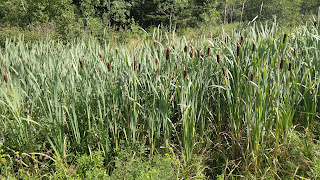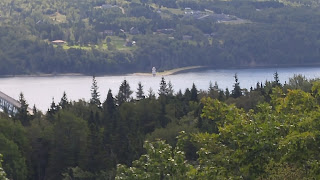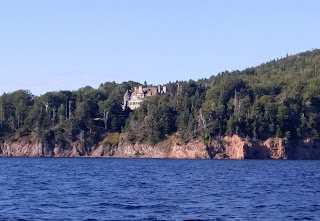Lost and found bouys and skeletal tuna tails.
Just one of many unique sights along the Cabot Trail
The route measures 298 km (185 mi) in length and completes a loop around the northern tip of the island, passing along and through the scenic Cape Breton Highlands. It is named after the explorer John Cabot who landed in Atlantic Canada in 1497, although most historians agree his landfall likely took place in Newfoundland and not Cape Breton Island. Premier Angus L. MacDonald attempted to re-brand Nova Scotia for tourism purposes as primarily Scottish and, as part of this effort, created both the names Cape Breton Highlands and Cabot Trail.
A beautiful view of the Atlantic Ocean from Cabot Trail
There are a number of hikes you can take through this area, including the Skyline Trail, which goes right along the top of a cliff. We saw some hikers doing just that while we were on our tour. You can also bike around the Cabot Trail but I don't know who in their right mind would do that. It is hilly!! There was some construction going on, but I didn't think it was bad at all. And we had no traffic or congestion problems at all. How nice to be someplace at the end of August (end of tourist season) and not have to be following five large tour buses! We only saw one the whole time.
There are a number of wonderful places to pull off the road to take pictures and/or to visit a lodge or interpretive centre. One of my favorite stops was near the beginning, which, for us, was on the East side. I absolutely fell in love with the rocky and rugged shoreline on the East side. The rocks were pink and sparkly! I learned that they are granite, and there is a lot of iron in the soil here, which lends to pinks and reds.
I loved finding this crystal in a boulder. I even tried to
pry it out!
Our guide (Harry) told us this is granite. You can't tell
by the picture, but in the sunlight it was sparkling!
Beautiful!
One of our stops was at the Keltic Lodge in Ingonish. It's a beautiful place to stay, at least from the outside and the lobby and gift shop.

I did not take this picture, but it gives you a great view of where
this lodge is located.
The flowers are front were gorgeous!
Ingonish is a rural community which lies at the eastern entrance of Cape Breton Highlands National Park. The economy relies heavily on tourism and fishing.
Next stop was at Neil's Harbour. Artifacts that have been discovered leads historians to believe that Neil's Harbour was founded by the French. This village is name after Neil MacLennan (very Scottish).
Crab pots for snow crab
Village of Neil's Harbour
Neil's Harbour Lighthouse turned ice cream shop.
We stopped for ice cream. I had this delicious salted
caramel ice cream with large chocolate chunks mixed in!
We stopped for lunch at the Mountain View restaurant where
I ate my very first lobster roll! Our guide likes to stop here
because it's less crowded and they have named a
fish burger after him - The Harry Burger.
You can see why it's called Mountain View. This is
Nova Scotia's idea of a mountain.
We continued on around the trail, onward and upward toward Cape Breton Highland National Park - the Highlands. The Scottish tourists say that this part of the Cabot Trail reminds them most of home in Scotland.
Can you almost imagine what those hills will look like when the leaves start to change colors? It would be breath-taking. Some of the trees were just starting to turn, so probably in another month it will be all oranges, yellows, reds and golds. "Next time."
Looking back on the road in which we had just come.
This reminds me a little bit of Central California, Big Sur area.
Cheticamp is a fishing community on the west side of the Cabot Trail. The village was established in 1785 and probably has the largest population and information of the Acadian people. It also is the home to a beautiful Catholic church - St. Peter's. St. Peter is the patron saint of fishing.
Looking out the window of the church, towards the
Cheticamp River, which feeds into the St. Lawrence River.
Beautiful pipe organ
After the tour, as I was driving home, I finally decided to stop and take a picture of these very unique signs - unique to Cape Breton. The top is English, the bottom is Gaelic. The Gaelic language appears to be quite complicated to read and to speak, but I love that this area is working to keep this language, and culture, alive.































































